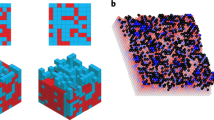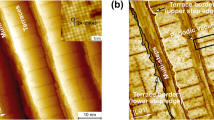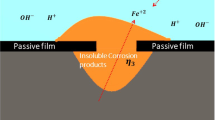Abstract
PITTING corrosion—the localized dissolution of a passivated (oxide-covered) metal in the presence of a solution of certain anionic species—is a major cause of failure of metal structures. The breakdown of extremely thin (∼1 nm thick), highly stable passivating layers typically occurs in a sporadic, localized and stochastic fashion1,2, rather than as a catastrophic, global process. Using a model of a random binary iron–chromium alloy, we have shown previously3–6 that experimental observations of passivity of stainless steels can be explained by assuming that it is controlled by the selective dissolution of iron7. Thus if the chromium content is above a certain threshold (the percolation limit8), clusters of iron are finite and dissolution will proceed for a while and then stop. Oxidation of surface chromium atoms to form Cr—O—Cr linkages then creates a passive state in which the entire surface is covered with such a layer3,5. Here we show that, by adding to this model the further assumption that there is a small but finite dissolution rate for surface chromium atoms, one obtains a mechanism for the triggering of pitting corrosion of stainless steels that is consistent with experimental studies.
This is a preview of subscription content, access via your institution
Access options
Subscribe to this journal
Receive 51 print issues and online access
$199.00 per year
only $3.90 per issue
Buy this article
- Purchase on Springer Link
- Instant access to full article PDF
Prices may be subject to local taxes which are calculated during checkout
Similar content being viewed by others
References
Williams, D. E., Westcott, C. & Fleischmann, M. J. electrochem. Soc. 132, 1796–1804 (1985); J. electmchem. Soc. 132, 1804–1811 (1985).
Shibata, T. & Takeyama, T. Nature 260, 315–316 (1976).
Sieradzki, K. & Newman, R. C. J. electrochem. Soc. 133, 1979–1980 (1986).
Newman, R. C., Foong, T. M. & Sieradzki, K. Corros. Sci. 28, 523–527 (1988).
Song, Q., Newman, R. C., Cottis, R. A. & Sieradzki, K. J. electrochem. Soc. 137, 435–439 (1990).
Song, Q., Newman, R. C., Cottis, R. A. & Sieradzki, K. Corros. Sci. 31, 621–626 (1990).
Burstein, G. T. & Marshall, P. I. Corros. Sci. 24, 449–462 (1984).
Stauffer, D. Introduction to Percolation Theory (Taylor & Francis, London, 1985).
Heusler, K. E. Corros. Sci. 31, 597 (1990).
Wiilliams, D. E., Westcott, C. & Fleischmann, M. in Passivity of Metals and Semiconductors: Proc. 5th Int. Symp. on Passivity Bombannes, France, 1983 (ed. Froment, M.) 217 (Elsevier, Amsterdam, 1983).
Balkwill, P., Stewart, J., Wells, D. B., Westcott, C. & Williams, D. E. in Corrosion Science and Engineering: Marcel Pourbaix 85th Birthday Symp. (eds Rapp, R. A., Gokcen, N. A. & Pourbaix, A.) 295–306 (CEBELCOR, Brussels, 1989).
Stewart, J. thesis, University of Southampton (1990).
Szlarska-Smialowska, Z. Pitting Corrosion of Metals (National Association of Corrosion Engineers, Houston, 1986).
Hakkarainen, T. in Corrosion Chemistry within Pits, Crevices and Cracks (ed. Turnbull, A.) 17–26 (HMSO, London, 1987).
Gaudet, G. T. et al. Am. Inst. Chem. Eng. J. 32, 949–958 (1986).
Westcott, C. in Electrochemistry Vol. 10: Spec. Per. Rep. (ed. Pletcher, D.) 85–116 (Royal Society of Chemistry, London, 1985).
Urquidi-Macdonald, M. & Macdonald, D. D. J. electrochem. Soc. 136, 961–967 (1989).
Heusler, K. E. & Fischer, L. Werkst. U Korros. 27, 551 (1976).
Hashimoto, K. in Passivity of Metals and Semiconductors: Proc. 5th Int. Symp. on Passivity Bombannes, France, 1983 (ed. Froment, M.) 247–252 (Elsevier, Amsterdam, 1983).
Okada, T. Corros. Sci. 31, 453–458 (1990).
Okada, T. Electrochim. Acta 33, 389 (1988).
Okada, T. J. electrochem. Soc. 131, 241 (1984).
Sato, N. J. electrochem. Soc. 129, 260–264 (1982).
Sieradzki, K., Corderman, R. R., Shukla, K. & Newman, R. C. Phil. Mag. A 59, 713–746 (1989).
Brüesch, P., Müller, K., Atrens, A. & Neff, H. Appl. Phys. A 38, 1 (1985).
Kruger, J., Long, G. G., Zhang, Z. & Tanaka, D. K. Corros. Sci. 31, 111–120 (1990).
Okamoto, G. Corros. Sci. 13, 471–489 (1973).
Asami, K., Hashimoto, K. & Shimodaira, S. Corros. Sci. 18, 151–160 (1978).
Mitchell, D. F., Sproule, G. I. & Graham, M. J. Appl. Surf. Sci. 21, 199–209 (1985).
Riley, A. M., Wells, D. B. & Williams, D. E. Corros. Sci. (in the press).
Author information
Authors and Affiliations
Rights and permissions
About this article
Cite this article
Williams, D., Newman, R., Song, Q. et al. Passivity breakdown and pitting corrosion of binary alloys. Nature 350, 216–219 (1991). https://doi.org/10.1038/350216a0
Received:
Accepted:
Issue Date:
DOI: https://doi.org/10.1038/350216a0
This article is cited by
-
Understanding the passive behaviour of low-chromium high-strength Hybrid steel in corrosive environments
npj Materials Degradation (2023)
-
Elemental partitioning and corrosion resistance of Ni–Cr alloys revealed by accurate ab-initio thermodynamic and electrochemical calculations
npj Materials Degradation (2023)
-
Plastic injection molding dies using hybrid additively manufactured 420/CX stainless steels: electrochemical considerations
npj Materials Degradation (2022)
-
A percolation theory for designing corrosion-resistant alloys
Nature Materials (2021)
-
Cold welding behavior of metallic glass nanowires: Insights from large-scale numerical simulations
Journal of Materials Science (2021)
Comments
By submitting a comment you agree to abide by our Terms and Community Guidelines. If you find something abusive or that does not comply with our terms or guidelines please flag it as inappropriate.



